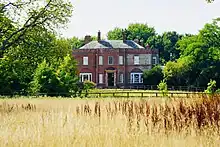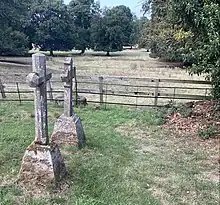
Lost Hearts is a 1973 supernatural drama produced by the BBC as part of its A Ghost Story for Christmas series. Running at 35 minutes and directed by Lawrence Gordon Clark, it was written by Robin Chapman[1][2] and was based on the 1895 short story "Lost Hearts" by M. R. James.
Synopsis

The drama tells the story of Stephen Elliott, a young orphan aged 11 years and of an inquiring frame of mind, who is sent to stay with his much older cousin, the scholarly Mr Abney, at a remote country mansion, Aswarby Hall, in Lincolnshire. His cousin is a reclusive alchemist obsessed with making himself immortal. Abney’s library "contained all the then available books bearing on the Mysteries, the Orphic poems, the worship of Mithras, and the Neo–Platonists."[3] Stephen is repeatedly troubled by visions of a young gypsy girl and a travelling Italian boy with their hearts missing.
Cast

- Mr Abney .. Joseph O'Conor
- Mrs Bunch .. Susan Richards
- Stephen .. Simon Gipps-Kent
- Parkes .. James Mellor
- Giovanni .. Christopher Davis
- Phoebe .. Michelle Foster
- Vicar .. Roger Milner[1][2]
Adaptation
Lost Hearts was adapted by Robin Chapman in 1973 as part of the BBC's A Ghost Story for Christmas strand, directed by Lawrence Gordon Clark. The shortest of the adaptations, it was first broadcast on Christmas Day 1973 at 11:35 pm.[4] It starred Simon Gipps-Kent as Stephen and Joseph O'Conor as Mr Abney.
Music
Most music from the film is taken from Hyperion III, a 1966 avant-garde piece by Bruno Maderna. The 25-minute recording was performed by the Southwest German Radio Symphony Orchestra, Baden Baden, with Severino Gazzelloni on the flute.[5] Also featured is My Bonny Boy from Ralph Vaughan Williams English Folk Song Suite, performed by the London Symphony Orchestra, conducted by Sir Adrian Boult.[6] This piece accompanies the scene of Stephen flying his kite. Two pieces from The Minstrel of Clare, a collection of Irish folk music by Willie Clancy, also feature: The Templehouse and Over the Moor to Maggie, and Caoineadh an Spailpín (The Spalpeen's Lament).[7] These are used during the flashbacks to Phoebe’s arrival at, and disappearance from, Abney’s house.
The adaptation is noted for the distinctive hurdy-gurdy music that accompanies appearances of the two ghostly children. This has been wrongly identified as L'amour De Moi, a 15th Century French folk song,[8] but BBC copyright documentation confirms that this title is instead the tune hummed briefly by Joseph O'Conor. The actual hurdy-gurdy tune is listed as an instrumental folk song; no title, performer or recordist are given.
Locations


Grade II* listed Ormsby Hall in South Ormsby in Lincolnshire stood in for the exterior shots of Aswarby Hall, while the churchyard of the nearby St Leonard's church in the village featured in the final scenes including the ghostly children waving to Stephen.
Harrington Hall in Harrington, Lincolnshire was used for the interior of Aswarby Hall, as well as a few outside scenes. The interiors seen in the film were all destroyed by a fire which occurred in 1991.
The Pelham Mausoleum near Brocklesby in Great Limber near Grimsby also featured in the production.
References
- 1 2 Lost Hearts (1973), British Film Institute (BFI) database
- 1 2 "BBC Four - Lost Hearts". BBC.
- ↑ Lost Hearts (1895), Project Gutenberg Canada Ebook
- ↑ "Lost Hearts". British Film Institute Database. Archived from the original on 16 January 2009. Retrieved 22 August 2010.
- ↑ Severino Gazzelloni - Flute Works By Debussy, Busoni / Weill, Varese, Bussotti, Matsudaira, Maderna, 2023-04-01, retrieved 2023-10-30
- ↑ Elgar, Vaughan Williams, London Symphony Orchestra, Sir Adrian Boult - Enigma Variations, English Folk Song Suite, Fantasia On 'Greensleeves', 1971, retrieved 2023-10-30
- ↑ Willie Clancy - The Minstrel From Clare, 1967, retrieved 2023-10-30
- ↑ "The Aural Aesthetics of Ghosts in BBC Ghost Stories – Part 4 (Music). – Celluloid Wicker Man". 2021-04-19. Archived from the original on 2021-04-19. Retrieved 2023-10-29.
External links
- Lost Hearts at IMDb